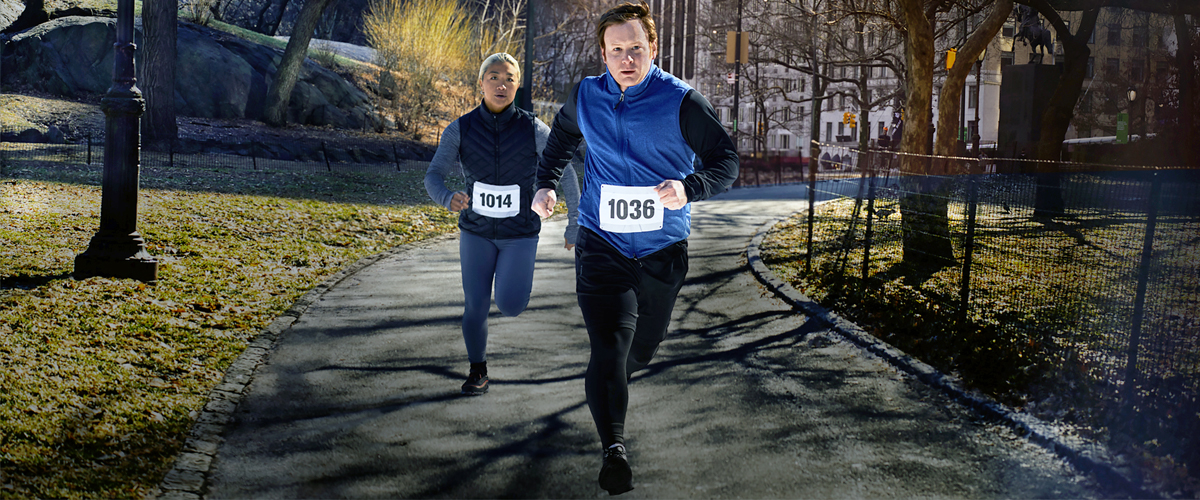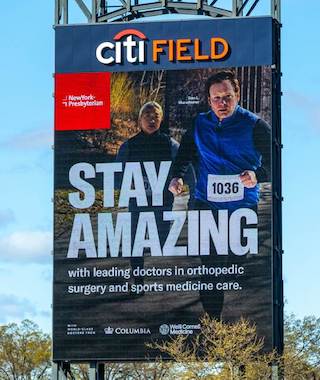Fighting to Move Forward
Having endured painful injuries and a difficult loss, patient Dan Levinsohn shares what this year's New York City Marathon represents to him.


Stuck in traffic on the Grand Central Parkway a few weeks back, I glanced out the bus window – and caught a 54-foot tall image of myself on the highway-facing LED screen outside Citi Field. My stomach dropped.
The display features me sprinting through Central Park with a race bib glued to a sports vest. Layers of clothing, fortuitous lighting, and a kind lens hide my body’s more noticeable curves; mousse and freezing temperatures, keep my hair coiffed.
Alluding to a major surgery, performed by orthopedic surgeons at NewYork-Presbyterian, the ad encourages New Yorkers to “STAY AMAZING” in big, bold print. Yet I didn’t exactly feel amazing during that single-digit January 2022 photo shoot – which captured me returning to a sport that almost cost me my arm, and my life.

The Stay Amazing billboard in Queens featuring Dan Levinsohn.
While training for the New York City Marathon on Labor Day, 2017, a driver struck me in the crosswalk between Brooklyn’s Classon and Flushing Avenues. I rocketed through the air upon impact: An unplanned, five-second flight led to seven busted bones and a half-decade of chronic pain. My right arm took the brunt of the damage. The humerus had split in four places, its “head” somehow landing in my armpit. The corresponding hand lost all sensation, while my fingers became borderline nonfunctional.
My mom, Iris, who had served as a care coordinator at NewYork-Presbyterian for 35 years and still worked there when I was hit, had me transferred to her “home hospital” in Manhattan, NewYork-Presbyterian/Columbia University Irving Medical Center. The head of orthopedics, Dr. William Levine, and his team of bonesaw-wielding puzzle-solvers reassembled the fracture by bolting the humerus and its fragments together via a plate and nine screws. A five-inch scar zippered up the hardware.
Back in the Garden State for three weeks of rest, Mom drove me to my first post-op check-up. Examining my arm, Dr. Levine recommended I begin physical and occupational therapy. I asked the natural follow-up: Could I still run the marathon? The answer was yes.
A month later — and four hours, six minutes, fourteen seconds — I crossed the finish line in Central Park. Mom offered a gentle smile when I showed her the medal. She seemed to understand why completing the race was so important to me, that I couldn’t walk away after years of preparation and focus.
Ascending the Herald Square subway stop escalator a few months later, I yawned big — stretching my arms as I rubbed my knuckles against my eyelids. The subsequent “crack” and pull in my shoulder reminded me that a very serious incident could have been much worse. I dialed Mom and blubbered “thank you” through warm, public tears.

Dan and his mom, Iris
“It’s no-thing,” she said. “Daniel, I’m your mo-ther.”
Another year of physical therapy, pills, and acupuncture passed. One chilly March evening, I took NJ Transit to the house at Mom’s request. She calmly explained that a recent brain scan stemming from an acoustic neuroma had revealed an “incidental finding.”
Just over two years later, on June 14, 2021, Mom’s intermittent wheezing contrasted with Carole King’s “Tapestry.” In those final moments, I clasped her bloated right hand with mine – but couldn’t really “feel” her when she died. The lingering effects of the crash still robbed me of sensation.
How does one accept long-term pain — physical and emotional? It’s a question I continue to struggle with.
What I know is: life hurts. It hurts even more when you’re blitzing through 26.2 miles as quickly as possible. I have completed the New York City Marathon every year since 2017, including via a “virtual” option during 2020; to claim I “ran” last year’s race, when I was 30 pounds overweight and grieving, is like saying a chicken soared through the air.
Yet ahead of each four hour-plus act of masochism, I find myself compelled to write, to try to articulate how the marathon represents the journey all of us are on. The marathon is often unpredictable and painful despite the utmost preparation — much like life in New York — yet it still rewards resilience just as the billboard I’m featured in celebrates New Yorkers by encouraging them to “Stay Amazing.”
Writing, running, involving myself in photo shoots, volunteering and fundraising for causes like Families for Safe Streets or the National Brain Tumor Society – they’re all methods, some more helpful than others, of dealing with loss. By rewriting and expanding the story each year, often touching on previous themes but with an increasingly refined perspective, I am able to acknowledge and contextualize this newest version of reality. That is the first, most crucial step when it comes to confronting, managing, and minimizing pain.
“The marathon is often unpredictable and painful despite the utmost preparation — much like life in New York — yet it still rewards resilience.”— Dan Levinsohn
Hence, the more pressing question: How do we continue to thrive in spite of pain? Studies emphasize the importance of gratitude and a positive attitude; further ingraining ourselves in our communities; and physical activity.
No longer can I call up my mother and thank her for helping with college tuition or my medical bills. Still, I’ll sit beside her grave a day or two before the marathon and tell her how excited I am to race again. Friends who were unable to visit or help during the pandemic have become more physically present in 2022: As COVID rates dropped and boosters provided additional protection, we’ve reconnected by training together, stretching after long runs, recapping races over drinks (sometimes alcoholic, sometimes caffeinated).
Just as no fracture perfectly mirrors another, there’s no single path or method towards recovery. Sometimes you just have to push forward and discover through trial and error what helps.
Hopefully, the “Stay Amazing” billboard of me running will at least encourage those with related joint issues to seek the best possible care; if the pandemic taught us nothing else, we’ve been forced to acknowledge the human body’s vulnerabilities. To anyone experiencing limitations or enduring pain, I’d like to offer my own pair of words: keep fighting.

